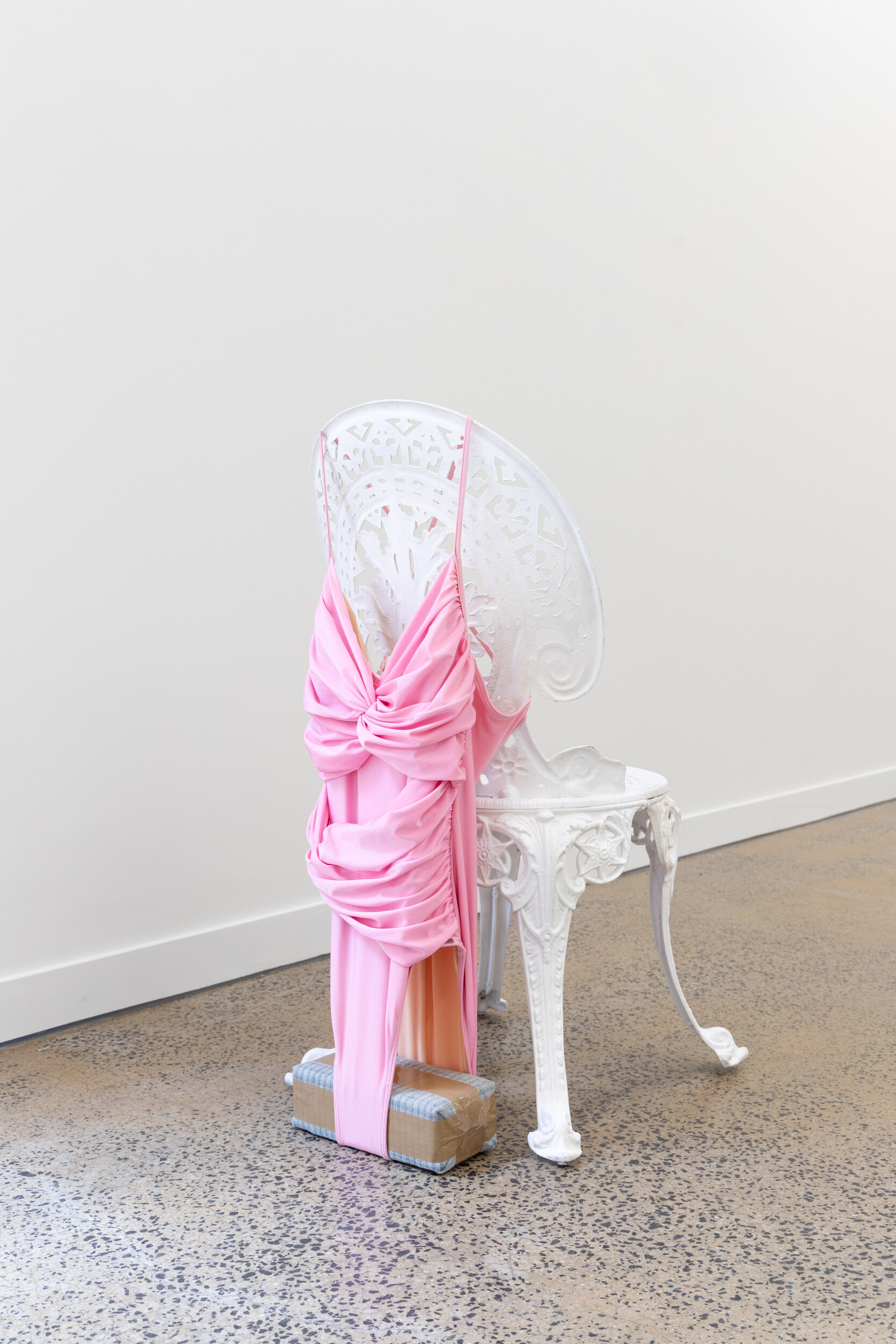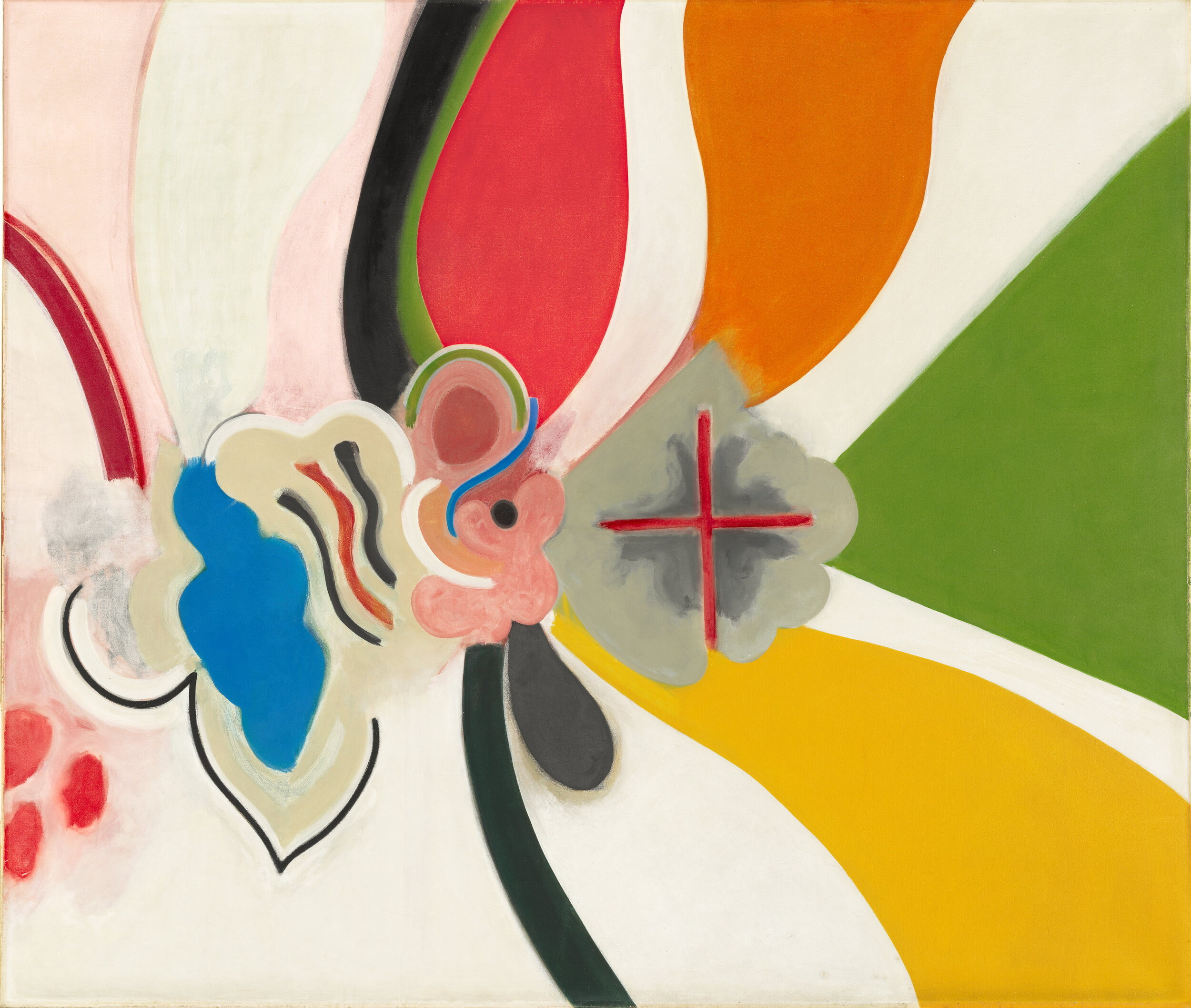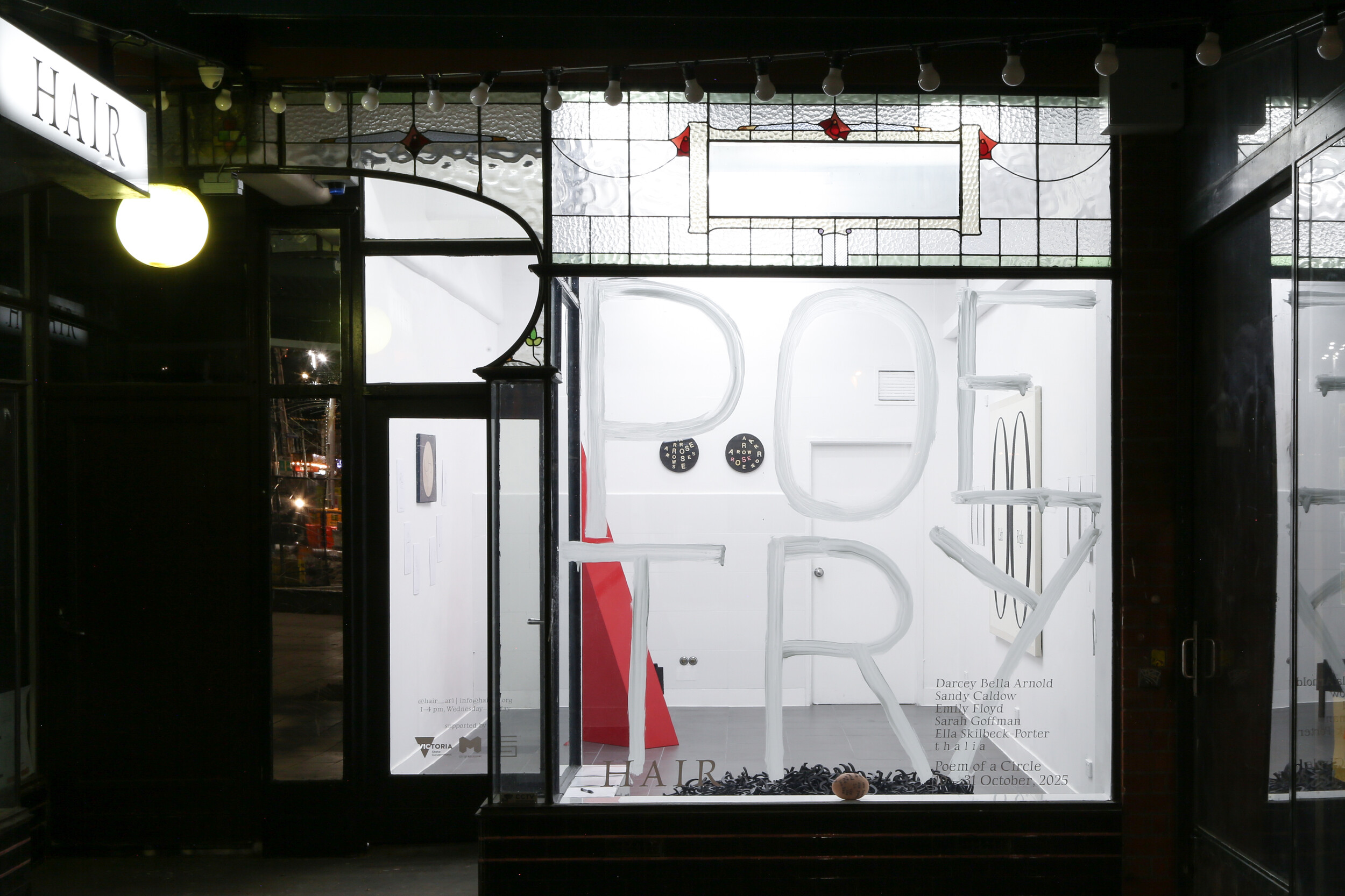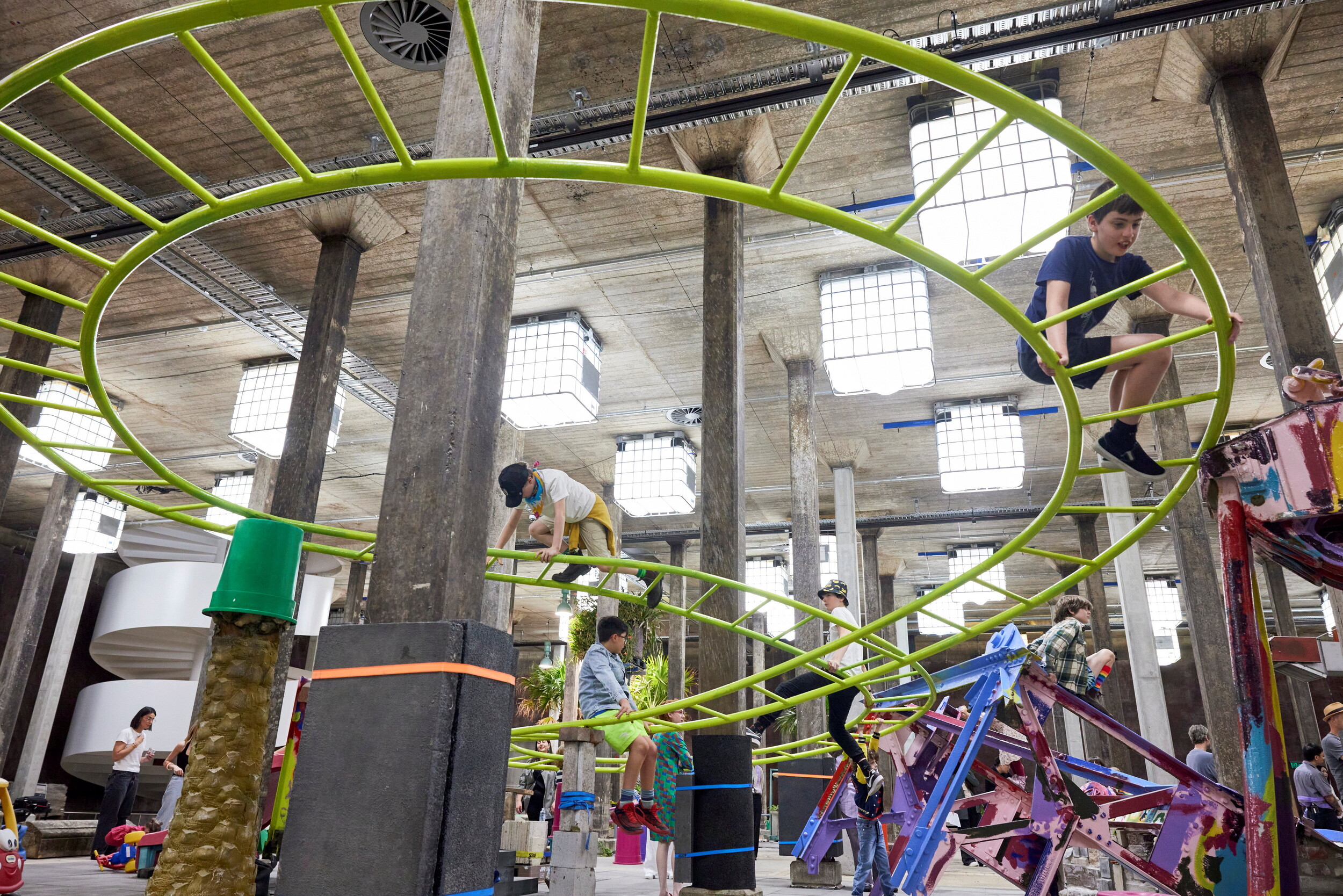Installation view of Lou Hubbard Grill felt Lamb at Sarah Scout Presents, Melbourne. Photo: Nicholas Mahady.
Grill felt lamb
Amelia Winata
In 2023, when I was curator at Gertrude Contemporary, I worked with Lou Hubbard on her solo exhibition Pleasure First. The exhibition was centred on a large inflatable pool with a netted base. This style of pool is traditionally trailed behind yachts so the passengers can experience being in the ocean without being in the ocean, and it was probably the size of two double beds. Pleasure First had very few pieces, but Hubbard used the whole two-week install period to finesse every aspect of the show. At one point, she decided that the white stitching that framed the perimeter of the pool’s big, netted base was jarring. What followed was Hubbard and me sitting on the gallery floor hand-colouring metres and metres of stitching with black permanent markers. The task felt, quite frankly, like overkill to me—though I never aired my reservations. Hubbard, on the other hand, approached the chore calmly. And her instinct paid off. The pool had a stronger presence with black stitching, sitting as a monolith suspended from Gertrude’s wall.
This moment crosses my mind upon entering Grill felt lamb at Sarah Scout Presents, Hubbard’s solo exhibition brimming with dozens of new, and a few old, works—some installations, others tiny knick-knacks—over which each I know Hubbard would’ve shed blood and tears fretting about the positioning and relationship between them. I wince looking at a plastic bag full of white, green and orange bread tags—certainly hundreds—hung from a wall in the back of the gallery behind a pillar (Use by, 2025). Hubbard would have fussed over the positioning of the bag so that it would emerge, just right, from behind the pillar at the moment when the viewer thought they had seen everything in the show. She would have also fastidiously arranged the bread tags so as to strike a balance between colours and orientation, and she would have made sure the crease in the centre of the bag was exactly the way it was meant to be. It’s an incredible work. Did she collect these tags from her own bread? If so, how long did it take her? And Use by is just one tiny element of Grill felt lamb.

Installation view of Lou Hubbard Grill felt Lamb at Sarah Scout Presents, Melbourne. Photo: Lou Hubbard.
A larger installation, Frame fit (2025), has been placed in the gallery’s courtyard so that the viewer witnesses it through the window. It is made of a cuboid angle-iron frame that houses a white cast-iron Coalbrookdale chair, which is very much synonymous with middle class suburban gardens. Viewed from inside the gallery, Frame fit lines up perfectly with the window, the chair symmetrically housed within. A cross brace typically used to stabilise Ikea bookshelves draws the viewer’s eye to the upturned chair. But what does it all mean? The formal outcome matters, but not because a piece might look good with a collector’s sofa. To call Hubbard’s work visually pleasing would be to miss the point. This is a meeting of nostalgia and mechanical precision. Hubbard’s work mines the depths of her youth—often painful or bittersweet memories—but presents them in a way that wholly avoids tipping into sloppy sentimentality or trauma porn. Her use of found items and industrially precise composition is key to this magic formula.

Frame Fit (2025) in Lou Hubbard Grill felt Lamb at Sarah Scout Presents, Melbourne. Photo: Nicholas Mahady.
Indeed, this exhibition feels like a mini survey of Hubbard’s life. On a wall of small curios is a pencil drawing of Hubbard and her sister as children made by her brother, Peter’s portrait of Lulu and Marion (1962). I’m told that David Onions (by Max Serong) (2025), a tiny sculpture made from a champagne muselet, is by one of Hubbard’s grandkids (she must be a cool grandma). Then there are the horses. If you know anything about Hubbard’s practice, you will know that the horse features heavily, though not exactly ad nauseam. In Grill felt lamb, the beast manifests nine times to my count, but it might be more. There are tiny versions carefully arranged around the gallery that could easily go undetected. Pink Box (2025) is a nine by twelve centimetre tulle-covered container that houses a tiny horse finger puppet. Hubbard’s real-life horse came when she was eleven, when her father ran away with another woman and offered the horse to Hubbard as a band-aid for his abandonment. Hubbard’s horses are, indeed, broken and decrepit, as though they have internalised her childhood despair. But just as Hubbard will recount these details of her life to you with a certain objectivity, the works, too, avoid any soppy psychoanalytic deep dive into daddy issues.
Horse set (2025) features a life-size latex horse on a trundle bed set upon Coalbrookdale patio tables. This specific horse was part of an installation titled Dead Still Standing which was originally acquired by the Art Gallery of Ballarat as part of the 2015 acquisitive Guirguis New Art Prize. In the intervening years the horse deteriorated, and the gallery deaccessioned the work, which is how it came back into Hubbard’s care. Now, it looks as though—to use an equine-themed metaphor—it has been ridden hard and put away wet. The horse’s two front legs have become detached from the body and stretch down the ground with the aid of black socks that act as proxy joints. Its belly, which was given form by a Coalbrookdale table in Dead Still Standing, now lies flat and deflated in Horse set. Around the corner and installed just below the ceiling height is Cast off (2025), a soft sculpture shell of the Horse set horse made from yellow adhesive tape. The cast has been laced between the rungs of an old-school style folding clothes horse, perhaps a play on words and a doubling down on the domestic melancholia in Hubbard’s work. In any case, it’s an exceptionally effective sculpture that demonstrates the mastery that Hubbard has over everyday objects.

Horse Set (2025) in Lou Hubbard Grill felt Lamb at Sarah Scout Presents, Melbourne. Photo: Nicholas Mahady.
What is so special about Grill felt lamb is that it is a rare opportunity to see discrete works by Hubbard en masse. Of course, the exhibition is in a commercial gallery, which relies upon sales to stay afloat. Hubbard is frequently featured in group shows amongst younger artists, often with her students. She is also a generous supporter of non-profit gallery fundraisers, regularly donating pieces to be auctioned off in aid of keeping the artist-run scene alive. And it’s so often the case that you will see one Hubbard work in amongst a whole lot by other artists. In recent instances of solo exhibitions—including the aforementioned Pleasure First at Gertrude and Skewered at Conners Conners (2023)—she has presented deliberately spare installations. At Sarah Scout, Hubbard has let loose—as much as her Type A personality will allow her—and where viewers have often been left to paste the repeating motifs together over viewings of several different shows (the horse, the Coalbrookdale chairs), here we see them literally in the same space.
And yet, the viewer’s previous experiences with Hubbard’s work are also critical to viewing Grill felt lamb. With a near cult-like following, Hubbard knows her viewers and their awareness of her practice. She harnesses this by inserting recognisable leitmotifs into the show, like phantoms from the past. There is the Barbie shoe that we vaguely remember seeing collaged in the 2017 Margaret Lawrence Gallery fundraiser 9x5 NOW, this time in what looks to me to be the form of a Mirena contraceptive device (Gold Rim, 2016). Or the chestnut puree tin that she most recently placed a table leg in for a 2023 exhibition at Kunstverein Amsterdam, here perched atop an oversized, faded pink plastic barrel that once held sweet mango chutney (Chestnut Chutney, 2025). I’m told she bought the item—seemingly a piece of detritus—in London and carted it back to Australia: further evidence of Hubbard’s keen eye for seeing the potential in spent or discarded everyday objects. My point here is that, in addition to creating links between objects in real time, Hubbard takes her viewer on a kind of journey down memory lane that then implants a sense of nostalgia in us to quasi-mimic the melancholia of her own associations with these icons of her early life.

Gold Rim (2025), in Lou Hubbard Grill felt Lamb at Sarah Scout Presents, Melbourne. Photo: Nicholas Mahady.

Lou Hubbard, Sand Bank (2017) in 9x5 NOW at Margaret Lawrence Gallery, Melbourne. Photo: Lou Hubbard.
In Melbourne, Hubbard is the mother of installation art. Indeed, if you see expanded assemblage and readymade installations around town, chances are those artists were taught by Hubbard at the VCA, where she is currently a senior lecturer. If you see something teetering on shit on the floor, then that’s an artist who thinks they are imitating Hubbard’s style, but who has missed the point of the balanced tension that her work epitomises. Hubbard has only occasionally shown outside of Australia, and many have often said that her work is quintessentially Melburnian. I think that people here are confusing her engagement with the Melbourne art scene with her style. To me, her work has a deeply international appeal. It is tender and funny and slick all at once. I sense whiffs of Isa Genzken or even Cady Noland, insofar as comedy is used as a salve for suffering. My favourite work in the current show, Brick Bathers (2025), is a brick in the crotch of a pair of ruched pink swimmers, literally stretching them down to the floor. There is a mild violence to this gesture, but it is ultimately difficult not to laugh at the absurdity of the combination of elements. Even the brick has been afforded extra love and care. Wrapped in a gingham tea towel and secured with masking tape, it presents like the prettiest, girliest cocaine brick.

Brick Bathers (2025), in Lou Hubbard Grill felt Lamb at Sarah Scout Presents, Melbourne. Photo: Nicholas Mahady.
Lou Hubbard is our Lou. We’re merely the loyal servants to a queen who has played a huge role in fostering the next generation of artists and supporting small orgs to stay afloat. I’ve been sitting on the conclusion to this review for a long time, trying to think of some witticism that would offset my overly gushy reaction to Grill felt lamb—a written version of the formal and humorous antidotes Hubbard inserts into her practice—but I can’t. The show is just so good. Go and see it for yourself.
Amelia Winata is a founding editor of Memo Review and a curator based in Naarm Melbourne. She holds a PhD in Art History from the University of Melbourne.


